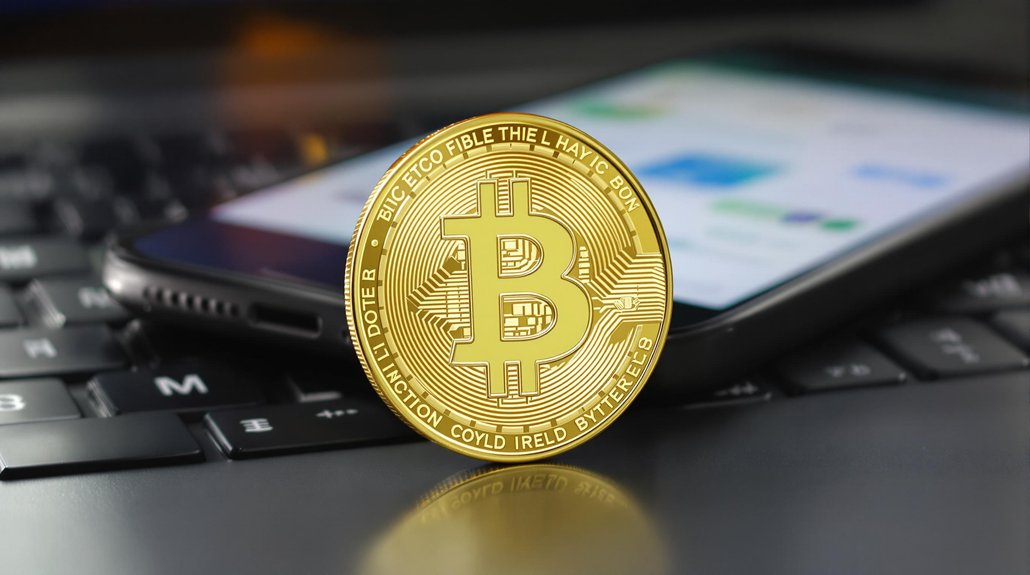Note: All blog posts on this website are 100% AI generated and has not been fact checked or edited. Do not rely on anything on this website. Instead, use it to learn about the output quality by ZimmWriter.
AIBlogPostWriter
Examples of 100% AI Written Articles by ZimmWriter
AIBlogPostWriter
Examples of 100% AI Written Articles by ZimmWriter

What Is Bitcoin? Definition, Basics & How to Use
Bitcoin is a revolutionary digital currency that lets you send and receive money without banks or intermediaries. Created in 2009 by Satoshi Nakamoto, it operates on a decentralized network called blockchain where every transaction is publicly recorded and verified by miners. You can buy Bitcoin through exchanges, store it in digital wallets, and use it for purchases at accepting merchants. While the total supply is capped at 21 million bitcoins, you can own fractions called satoshis. Its value has grown considerably since inception, though it's known for price volatility. Understanding Bitcoin's core features and security measures will help you navigate this groundbreaking financial technology.
Key Takeaways
- Bitcoin is a decentralized digital currency created in 2009 that enables peer-to-peer transactions without intermediaries like banks or governments.
- Transactions are recorded on a public blockchain ledger, verified by miners, and secured through advanced cryptography.
- Users can buy, sell, or trade Bitcoin through cryptocurrency exchanges, storing their funds in digital wallets.
- Bitcoin has a fixed supply of 21 million coins, making it a potentially scarce asset often used for investment.
- To use Bitcoin, set up a wallet, purchase coins through an exchange, and secure private keys for transaction control.
Bitcoin at a Glance
Innovation drives the cryptocurrency revolution, with Bitcoin leading the charge as the world's first and most prominent digital currency. It's a decentralized digital asset that lets you send money directly to anyone worldwide without relying on banks or governments.
You'll find Bitcoin operates on a blockchain, a public ledger that records all transactions transparently and permanently. The transaction fees can fluctuate based on network demand. What makes it unique is its fixed supply of 21 million bitcoins and its ability to be divided into smaller units called satoshis. Since its creation in 2009 by Nakamoto, Bitcoin has transformed from a niche experiment to a globally recognized financial asset.
You can store your Bitcoin in digital wallets or on cryptocurrency exchanges. The system uses advanced cryptography with public and private keys to keep your transactions secure. Investors commonly view Bitcoin as a speculative investment rather than a traditional currency.
While Bitcoin mining requires significant energy consumption, the network remains secure through proof-of-work consensus, ensuring every transaction is verified and immutable.
The Story Behind Bitcoin

Bitcoin's remarkable journey began in 2008 when a mysterious figure using the pseudonym Satoshi Nakamoto published a whitepaper that would revolutionize finance. This groundbreaking document introduced a decentralized digital currency that wouldn't need banks or intermediaries. The whitepaper specifically addressed the double-spending problem that had plagued previous digital currency attempts.
On January 3, 2009, Satoshi mined the Genesis Block, officially launching Bitcoin's blockchain. The block contained a strong political message referencing a newspaper headline about bank bailouts. The blockchain technology ensures transactions are stored across multiple computers, maintaining transparency and immutability.
Key moments that shaped Bitcoin's history:
- The first real-world transaction occurred in 2010 when someone paid 10,000 BTC for two pizzas
- Bitcoin's price hit $1,000 for the first time in 2013
- El Salvador made history by adopting Bitcoin as legal tender
Bitcoin's development was influenced by earlier digital cash concepts like b-money and bit gold.
While the identity of Satoshi remains unknown, their creation has sparked a global financial revolution, inspiring thousands of other cryptocurrencies and gaining institutional recognition worldwide.
How Bitcoin Actually Works

The complex machinery of Bitcoin operates through an ingenious system of interconnected mechanisms. When you send Bitcoin, your transaction joins a queue called the mempool, where miners pick it up for processing.
These miners use powerful computers to solve cryptographic puzzles, competing to create new blocks in the blockchain. Each block contains essential information: transaction data, timestamps, and a unique identifier called a nonce. When first using Bitcoin, new wallet installations automatically generate your first address.
For enhanced security, Bitcoin transactions utilize HTTPS protocol for data transmission. Recent analysis shows Bitcoin has demonstrated strong momentum with RSI values above 70. Miners adjust this nonce repeatedly until they find a solution that meets the network's difficulty target. When successful, they'll add the block to the blockchain, confirming your transaction and earning Bitcoin as a reward.
Your transaction's security comes from private keys that prove ownership and the decentralized nature of mining, which prevents any single entity from controlling the network.
The higher the fee you pay, the faster miners will process your transaction.
Core Features of Bitcoin

Standing alongside traditional financial systems, Bitcoin's core features establish its reputation as a revolutionary digital currency. Through its full node capabilities, Bitcoin Core validates and relays transactions while maintaining a complete copy of the blockchain, ensuring network security and decentralization. The software's evolution from Bitcoin-qt to Bitcoin Core marked a significant milestone in creating a more accessible platform. Approximately 97% of Bitcoin nodes run Bitcoin Core software, demonstrating its widespread adoption and trust within the community. The wallet requires 210GB of storage space for full functionality, reflecting its comprehensive approach to blockchain validation.
- You'll have complete control over your funds with built-in wallet functionality, allowing you to send and receive bitcoins while storing private keys locally on your device.
- Your privacy is enhanced through features like Tor support, VPN compatibility, and HD wallets, eliminating the need for third-party services.
- You're contributing to network strength when running Bitcoin Core, as you'll help validate transactions and support new users in syncing their software securely.
These core features work together to provide you with a secure, private, and sovereign financial experience while supporting the broader Bitcoin ecosystem.
Getting Started With Bitcoin

Building upon these core features, starting your Bitcoin journey requires understanding a few key elements.
You'll need to set up a digital wallet, which can be either a hot wallet (online) or cold wallet (offline), to store your bitcoin securely. Your wallet will generate public keys for receiving bitcoin and private keys for spending it. The security of your transactions is maintained through proof of work, which validates and records all activities on the blockchain. The decentralized network allows you to conduct transactions without any intermediary banks or institutions.
To acquire bitcoin, you can use cryptocurrency exchanges like Coinbase, where you'll be able to buy, sell, and trade. You don't need to purchase a whole bitcoin – you can buy fractional amounts, with the smallest unit being a Satoshi.
Once you've set up your wallet and obtained bitcoin, you'll want to implement security measures like strong passwords, two-factor authentication, and regular backups of your wallet data to protect your investment.
Risks and Security Measures

Despite its revolutionary potential, Bitcoin comes with significant security risks that every investor must understand. Cybercriminals frequently target Bitcoin users through phishing attacks, exchange hacks, and malware. Regular software updates and patches are critical for maintaining security against emerging threats. The rapid growth of the cryptocurrency market has made it an increasingly attractive target for cyber threats. Utilizing a hardware wallet for offline storage provides one of the strongest security measures available.
You'll need to stay vigilant against attackers who masquerade as legitimate entities to steal your private keys or login credentials. Centralized exchanges can also be vulnerable, as demonstrated by major hacks like Mt. Gox and Coincheck that resulted in losses worth hundreds of millions.
- Never share your private keys or wallet recovery phrases with anyone
- Use two-factor authentication and strong, unique passwords for all accounts
- Store significant amounts of Bitcoin in cold wallets rather than on exchanges
These security measures are essential because once your Bitcoin is stolen, transactions can't be reversed, and there's typically no way to recover your funds.
Bitcoin as Digital Money

Bitcoin represents a revolutionary form of digital money that operates on a decentralized peer-to-peer network. Unlike traditional currencies, you don't need banks or governments to use or transfer bitcoin. Instead, you'll rely on a public blockchain that records all transactions transparently and permanently.
When you own bitcoin, you're using public and private keys to manage your funds. Your private key acts like a digital signature, allowing you to send bitcoin to others' public addresses.
Every transaction you make is verified by miners who solve complex mathematical problems and add new blocks to the blockchain. These miners earn bitcoin rewards for their work, contributing to the fixed supply cap of 21 million coins.
You can't spend the same bitcoin twice because the network tracks and validates every transaction.
Future of Bitcoin Technology

While the current Bitcoin network has revolutionized digital money, technological advancements promise to address its limitations and expand its capabilities.
The upcoming Bitcoin halving event will reduce mining rewards and potentially reshape the mining landscape. You'll see major improvements through solutions like the Lightning Network, which enables faster and cheaper transactions, and Layer-2 protocols that boost scalability. Major corporations are increasingly holding Bitcoin on their balance sheets. The emergence of decentralized finance platforms since 2015 has created new opportunities for Bitcoin integration.
Integration with DeFi platforms and smart contracts will reveal new financial possibilities, while zero-knowledge proofs will enhance privacy.
Key developments you should watch for:
- Lightning Network and Layer-2 solutions making transactions nearly instant and cost-effective
- Integration with mainstream payment platforms and increased merchant adoption
- Advanced mining technology reducing environmental impact and improving sustainability
These innovations, combined with growing institutional interest and potential regulatory clarity, could transform Bitcoin from primarily a store of value into a more versatile digital asset by 2030.
Frequently Asked Questions
How Can I Earn Bitcoin Without Buying or Mining It?
Time to grab your piece of the digital gold rush!
You can earn bitcoin through various paths without mining or buying. You'll find opportunities by working for companies that pay in bitcoin, joining affiliate programs like Coinbase's referral system, or completing tasks on bitcoin faucet websites.
Additionally, you can earn by running lightning nodes, offering freelance services on crypto platforms, or participating in crypto-based reward programs.
What Happens to Lost Bitcoin When Owners Lose Their Private Keys?
When you lose your private keys, your Bitcoin remains forever frozen in the blockchain.
You can't recover it, and no one else can access it either – it's permanently locked away.
There's no central authority that can help you retrieve it.
These lost coins effectively reduce Bitcoin's total supply, as they'll never circulate again.
That's why it's vital you securely store your private keys.
Can Bitcoin Transactions Be Traced Back to Specific Individuals?
Yes, Bitcoin transactions can be traced back to you if you're not careful.
While Bitcoin offers pseudonymity, your transactions are recorded on a public blockchain that anyone can view.
Law enforcement and blockchain analysts can link your identity through exchanges where you've completed KYC verification, your spending patterns, and wallet addresses.
If you want more privacy, you'll need to use additional tools like mixers or privacy coins.
Why Do Some Countries Ban Bitcoin While Others Embrace It?
Like a pendulum swinging between extremes, countries' stances on Bitcoin reflect their priorities and concerns.
You'll find nations banning it due to fears of financial instability, money laundering, and loss of monetary control.
Others embrace it, seeing opportunities for economic growth and financial innovation.
Your location determines whether you can freely trade Bitcoin, as governments weigh the balance between potential risks and technological advancement.
How Does Bitcoin's Value Remain Stable Without Any Backing Authority?
Bitcoin's stability comes from multiple self-regulating mechanisms, even without a central authority.
You'll find its value maintained through blockchain technology's built-in security and the basic economic principle of limited supply (21 million max).
Market forces like global trading volume and growing adoption rates also help stabilize prices.
Additionally, you're protected by cryptographic security and decentralized verification, making manipulation extremely difficult.


